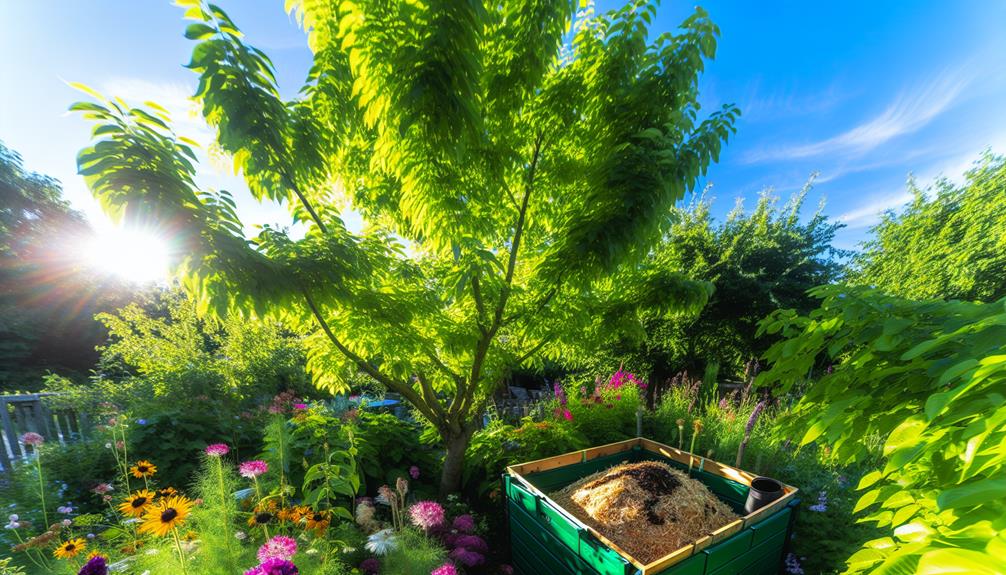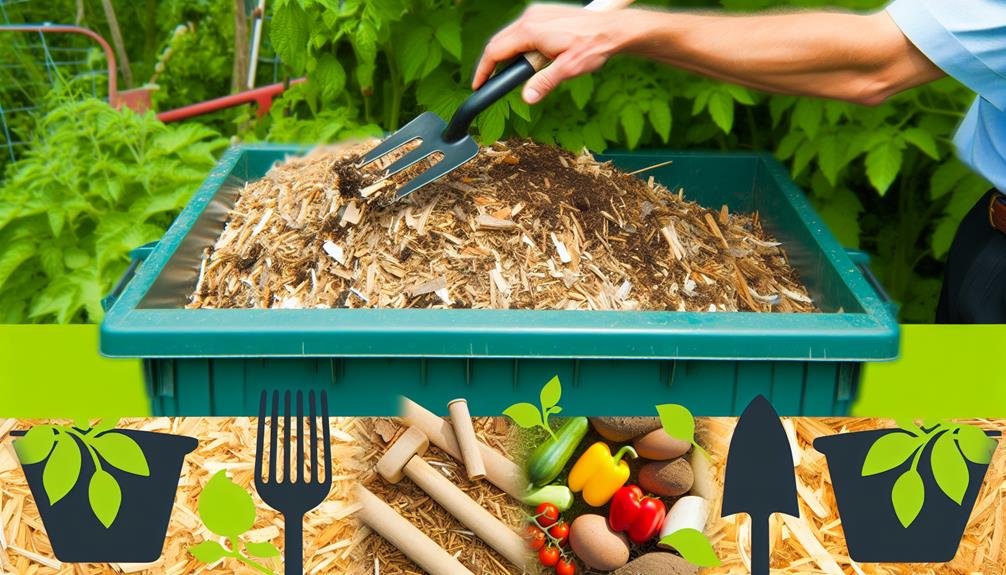

You can compost animal bedding to create nutrient-rich soil and reduce waste. Use materials like straw, wood shavings, sawdust, and even shredded paper, but avoid treated wood and glossy papers. Animal bedding provides essential carbon, balancing nitrogen-rich compostables.
Mix it with food scraps and garden waste to maintain proper decomposition. Guarantee sufficient airflow and moisture by turning the pile regularly. Manure can be added but choose based on its nitrogen content. By composting, you’ll boost soil structure, moisture retention, and plant health. There’s much more to discover on effectively composting and troubleshooting techniques to optimize your compost pile.
When composting animal bedding, it’s important to understand the different types available, such as straw, wood shavings, and sawdust.
Straw is a popular choice because it’s lightweight and decomposes relatively quickly.
Wood shavings are another common option; they provide good absorbency but take longer to break down.
Sawdust, while also absorbent, can compact easily and may require frequent turning to guarantee proper aeration.
Each type of bedding has its own characteristics, so you’ll need to take into account factors like decomposition rate and moisture retention.
Mixing different types can balance their individual properties, promoting effective composting.
Always make sure the bedding is free from contaminants or chemicals that could hinder the composting process or harm your garden soil.
Also Read: Can You Compost Agave?
Composting animal bedding has multiple advantages that can benefit both your garden and the environment.
By turning used bedding into compost, you create a nutrient-rich soil addition, which enhances plant growth.
Additionally, it serves as an effective waste reduction strategy, minimizing landfill contributions.
Adding composted animal bedding to your garden soil boosts its nutrient content, promoting healthier plant growth. The decomposed bedding enriches the soil with essential nutrients, leading to more robust plants and better yields. Here’s why you should consider it:
By composting animal bedding, you greatly reduce waste and turn a potential disposal problem into a valuable resource. Instead of sending used bedding to landfills, you can transform it into nutrient-rich compost that benefits your garden. This process helps decrease the volume of waste you generate and supports a more sustainable lifestyle.
To get started, mix the bedding with other compostable materials like kitchen scraps and yard waste. Guarantee adequate airflow and moisture to speed up decomposition. Regularly turning the compost pile will help maintain ideal conditions.
Also Read: Can You Compost Your Cotton Swabs? (This Might Surprise You)
When composting hay and straw from animal bedding, you’ll find they make excellent nutrient-rich additives for your compost pile.

Be mindful of the breakdown time, as straw tends to decompose slower than hay.
To speed up the process, you can mix these materials with green waste like vegetable scraps or grass clippings.
Hay and straw from animal bedding make excellent nutrient-rich additives for your compost. These materials break down well and enrich your compost pile with essential nutrients.
Here’s why you should add them:
Make sure to mix them thoroughly with other compost materials to optimize the decomposition process.
Understanding the factors that influence how quickly hay and straw break down in your compost can help you optimize your composting process.
First, consider the particle size. Smaller pieces of hay and straw decompose faster due to increased surface area. You can speed up the breakdown by chopping them into smaller bits.
Second, moisture levels play an important role. Keep the compost pile damp, but not waterlogged, to maintain microbial activity.
Third, aeration is essential; frequently turn the pile to ensure sufficient oxygen flow.
Lastly, balance the carbon-to-nitrogen ratio by adding green materials like kitchen scraps.
Also Read: Can You Compost Bacon Grease?
Wood shavings make an excellent addition to your compost pile, providing both carbon and aeration. They help balance the nitrogen-rich materials, like kitchen scraps and grass clippings, ensuring an ideal composting process.
When integrating wood shavings into your compost, remember these key points:
Incorporating wood shavings into your compost not only aids in decomposition but also improves the overall structure, making it easier to turn and aerate.
Shredded paper is an excellent compost material that adds essential carbon to balance the nitrogen-rich components in your pile. You can use it as bedding for animals, and when it’s soiled, it becomes a valuable addition to your compost heap.
Make sure to avoid glossy or heavily inked papers, as these can introduce unwanted chemicals into your compost. Tear the paper into smaller pieces to speed up decomposition.
Mix the shredded paper thoroughly with other compost materials to guarantee proper aeration and moisture distribution. This helps maintain a balanced compost pile, preventing it from becoming too wet or compacted.
Just remember, moderation is key; too much paper can overwhelm your compost, so aim for a balanced mix.
Also Read: Can You Compost Bacon?
Sawdust, a byproduct of woodworking, can be an excellent addition to your compost pile when used correctly. It’s rich in carbon and helps balance nitrogen-rich materials like kitchen scraps.
To effectively compost sawdust, follow these tips:
When composting animal bedding, you should consider the type of manure you’re adding to guarantee the compost’s success. Different manures have varying nutrient levels and decomposition rates. For example, horse manure is high in nitrogen and mixes well with bedding materials like straw. Chicken manure, though rich in nitrogen, requires more careful management due to its high ammonia content.
Here’s a quick comparison:
| Type of Manure | Nitrogen Content | Special Considerations |
|---|---|---|
| Horse | High | Mixes well with straw |
| Chicken | Very High | Manage ammonia levels carefully |
| Cow | Moderate | Good for balanced compost |
| Rabbit | High | Can be used directly in gardens |
| Pig | Low | Requires more carbon materials |
Use this table to make informed decisions about the manure you choose for composting.
To start the composting process, gather your animal bedding and manure in a designated area, ensuring a balanced mix of carbon and nitrogen-rich materials. The bedding, typically high in carbon, works well with nitrogen-rich manure.
Here’s what you should do next:
If your compost pile smells bad or isn’t breaking down properly, you may need to make some adjustments. First, check the moisture level. If it’s too wet, add dry materials like straw or shredded cardboard. If it’s too dry, sprinkle some water.

Make sure you have a balanced mix of green (nitrogen-rich) and brown (carbon-rich) materials. Turn the pile regularly to aerate it, promoting faster decomposition.
If your compost is still not breaking down, it might lack nitrogen. Add more green materials like grass clippings or kitchen scraps. Finally, confirm that your pile is in a sunny spot to maintain warmth, which aids decomposition.
In conclusion, you can effectively compost various types of animal bedding like hay, straw, wood shavings, shredded paper, and sawdust.
Make sure to balance carbon-rich bedding with nitrogen-rich manure for best results.
Maintain proper moisture and aeration throughout the composting process.
By following these steps, you’ll convert animal bedding into valuable compost for your garden.
Troubleshoot any issues promptly to guarantee successful composting.
This approach not only reduces waste but also enriches your soil.
